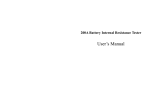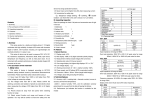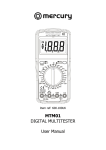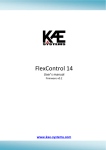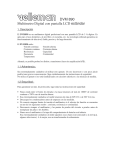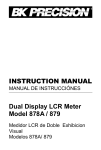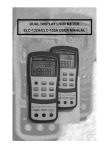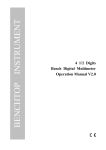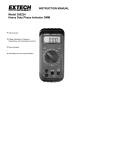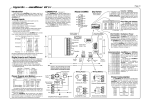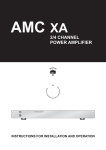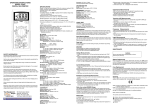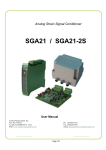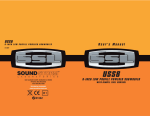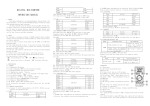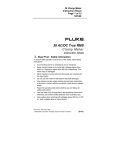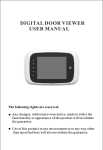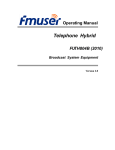Download MY65englis 修改后
Transcript
DIGITAL MULTIMETER USER’S MANUAL CONTENTS 1. SAFETY INFORMATION……………………………1 2. DESCRIPTION……………………………………….3 3. OPERATING INSTRUCTION……………………….5 3.1 Measuring voltage………………………………..5 3.2 Measuring current………………………………..6 3.3 Measuring resistance…………………………….6 3.4 Measuring frequency…………………………….7 3.5 Measuring capacitance………………………….7 3.6 Testing diode……………………………………..8 3.7 Testing transistor…………………………………8 3.8 Testing continuity………………………………...8 4. SPECIFICATIONS…………………………………...9 5. ACCESSORIES……………………………………..12 6. BATTERY & FUSE REPLACEMENT……………..13 1. SAFETY INFORMATION This multimeter has been designed according to IEC 1010 concerning electronic measuring instruments with an overvoltage category ( CATⅡ) and pollution 2. Follow all safety and operating instructions to ensure that the meter is used safely and is kept in good operating condition. 1.1 PRELIMINARY ※ When using this meter, the user must observe all normal safety rules concerning: — Protection against the dangers of electrical current. — Protection of the meter against misuse. ※ Full compliance with safety standards can be guaranteed only if used with test leads supplied. If necessary, they must be replaced with the same model or same electronic ratings. Measuring leads must be in good condition. 1.2 DURING USE ※ Never exceed the protection limit values indicated in specifications for each range of measurement. ※ When the meter is linked to measurement circuit, do not touch unused terminals. ※ When the value scale to be measured is unknown beforehand, set the range selector at the highest position. ※ Before rotating the range selector to change -1- functions, disconnect test leads from the circuit under test. ※ When carrying out measurements on TV or switching power circuits, always remember that there may be high amplitude voltages pulses at test points which can damage the meter. ※ Never perform resistance measurements on live circuits. ※ Always be careful when working with voltages above 60V dc or 30V ac rms. Keep fingers behind the probe barriers while measuring. 1.3 SYMBOLS Important safety information, refer to the operating manual. Dangerous voltage may be present. Earth ground Double insulation (Protection class Ⅱ) 1.4 MAINTENANCE ※ Before opening the meter, always disconnect test leads from all sources of electric current. ※ For continue protection against fire, replace fuse only with the specified voltage and current ratings: F1: 2A/250V F2: 10A/250V ※ If any faults or abnormalities are observed, the meter can not be used any more and it has to be -2- checked out. ※ Never use the meter unless the back cover is in place and fastened fully. ※ To clean the meter, use a damp cloth and mild detergent only, do not use abrasives or solvents on it. 2. DESCRIPTION This meter is a portable professional measuring instrument with 3 1/2 digits LCD, capable of performing functions: - DC voltage measurement, 5 ranges from 200mV to 1000V - AC voltage measurement, 4 ranges from 2V to 700V - DC current measurement, 4 ranges from 2mA to 10A - AC current measurement, 4 ranges from 2mA to 10A - Resistance measurement, 7 ranges from 200Ω to 200MΩ - Capacitance measurement, 5 ranges from 2000pF to 20µF - Diode test - Transistor test - Audible continuity test NAMES OF COMPONENTS 1. Power Switch 2. Data hold key 3. Capacitance measurement socket 4. 10A input jack -3- 5. mA input jack 6. COM Input Jack 7. V/Ω/Hz Input Jack A Input Jack 8. Rotary Switch 9. Transistor Testing Socket 10. LCD Display 2.3 INPUT JACKS This meter has four input jacks that are protected against overload to the limits. During use, connect the -4- black test lead to the COM jack and red test lead as shown below: RED LEAD FUNCTION INPUT LIMITS CONNECTION DCV / ACV V /Ω/Hz 1000V DC or 750V rms AC Ω V /Ω/Hz 250V DC or rms AC V /Ω/Hz 250V DC or rms AC Hz V /Ω/Hz 250V DC or rms AC mA mA 200mA DC or rms AC A A 10A DC or rms AC continuous 20A for 15 seconds maximum 3. OPERATING INSTRUCTION 3.1 MEASURING VOLTAGE 1. Connect the black test lead to the COM jack and the red test lead to the V/Ω jack. 2. Set the rotary switch at the desired V or V ~ range position and connect test leads across the source or load under measurement. 3. Read LCD display. The polarity of the red connection will be indicated when making a dc voltage measurement. 4. When only the figure“1”is displayed, it indicates overrange situation and the higher range has to be selected. -5- 3.2 MEASURING CURRENT 1. Connect the black test lead to the COM jack and the red test lead to the mA jack for a maximum of 200mA. For a maximum of 20A, move the red lead to the 10A jack. 2. Set the rotary switch at desired A or A ~ range position and connect test leads in series with the load under measurement. 3. Read LCD display. The polarity of the red lead connection will be indicated when making a DC measurement. 4. When only the figure“1”displayed, it indicates overrange situation and the higher range has to be selected. 3.3 MEASURING RESISTANCE 1. Connect the black test lead to the COM jack and the red test lead to the V/Ω/Hz jack. (NOTE: The polarity of red lead connection is positive “+”) 2. Set the rotary switch at desired Ω range position and connect test leads across the resistance under measurement. Read LCD display. NOTE: 1. For resistance above 1MΩ, the meter may take a few seconds to stabilize reading. 2. When the input is not connected, i.e. at open circuit, the figure “1”will be displayed for the overrange condition. 3. When checking in - circuit resistance, be sure the -6- circuit under test has all power removed and all capacitors are full discharged. 4. At 200MΩ range display is 1000 counts when test leads are shorted. These counts have to be subtracted from measuring results. For example, when measuring 100MΩ resistance, the reading will be 110.00 and the correct measuring result should be 110.0 0— 10.00 = 100.00MΩ. 3.4 MEASURING FREQUENCY 1. Connect the black test leads to the COM jack and the red test lead to the V /Ω/Hz jack. 2. Set the rotary switch at 20KHz position and connect test leads across the source or load under measurement. NOTE: 1. Reading is possible at input voltages above 10Vrms, but the accuracy is not guaranteed. 2. In noisy environment, it is preferable to use shield cable for measuring small signal. 3.5 MEASURING CAPACITANCE 1. Set the rotary switch at desired F position. 2. Before inserting capacitor under measurement into capacitance testing socket, be sure that the capacitor has been discharged fully. 3. When measuring capacitors with shorter leads, a testing adapter is provided with the meter. Insert the adapter into the capacitance testing socket on the front -7- panel to continue measurements. WARNING! To avoid shock, be sure the capacitor measuring adapter has been removed before changing to another function measurement. 3.6 TESTING DIODE 1. Connect the black test lead to the COM jack and the red test lead to the V/Ω jack. ( NOTE: The polarity of red lead connection is positive“ + ”) position and connect the 2. Set the rotary switch at red lead to the anode, the black lead to the cathode of the diode under testing. The meter will show the approx. Forward voltage drop of the diode. If the lead connection is reversed, only figure“1”will be displayed. 3.7 TESTING TRANSISTOR 1. Set the rotary switch at hFE position. 2. Identify whether the transistor is NPN or PNP type and locate Emitter, Base and Collector lead. Insert leads of the transistor to be tested into proper holes of the testing socket on the front panel. 3. LCD display will show the approximate hFE value at the test condition of base current 10µA and Vce 3.2V. 3.8 TESTING CONTINUITY 1. Connect the black test lead to the COM jack and the red test lead to the V/Ω jack. -8- 2. Set the rotary switch at position and connect test leads across two points of the circuit under testing. If continuity exists ( i.e. resistance less than about 70Ω ), built — in buzzer will sound. 4. SPECIFICATIONS Accuracy is specified for a period of one year after calibration and at 18°C to 28°C (64°F to 82°F) with relative humidity to 80%. Accuracy specifications are given as: ± % of reading ± number of least significant digits. 4.1 GENERAL MAXIMUM VOLTAGE BETWEEN TERMINALS AND EARTH GROUND: 1000V DC or 700 rms AC (sine) FUSE PROTECTION: A: 2A/250V; 10A: 10A/250V POWER SUPPLY: 9V battery, NEDA 1604 or 6F22 DISPLAY: LCD, 19999 counts MAX, updates 2-3/sec MEASURING METHOD: Dual - slope integration A/D converter OVERRANGE INDICATION: “1” figure only on the display POLARITY INDICATION: “—” displayed for negative polarity LOW BATTERY INDICATION:“ ”displayed OPERATING TEMPERATURE: 0°C to 40°C (32°F to 104°F) -9- STORAGE TEMPERATURE: -10°C to 50°C (14°F to 122°F) DIMENSION: 91×189×31.5mm WEIGHT: 310g (including battery) 4.2 DC VOLTAGE Range Resolution 200mV Accuracy 0.1mV ± 0.05 % of rdg ± 5 digit 2V 1mV ± 0.1 % of rdg ± 3 digit 20V 10mV ± 0.1 % of rdg ± 3 digit 200V 100mV ± 0.1 % of rdg ± 3 digit 1000V 1V ± 0.15 % of rdg ± 5 digits Input Impedance: 10MΩ. 4.3 AC VOLTAGE Range Resolution Accuracy 50Hz ~ 60Hz 40Hz ~ 100Hz ± 0. 6 % ± 10 ± 1.0 % ± 10 ± 0. 6 % ± 10 ± 1.0 % ± 10 ± 0. 6 % ± 10 ± 1.0 % ± 10 ± 0. 8 % ± 10 ± 1.2 % ± 15 2V 0.1mV 20V 1mV 200V 10mV 700V 0.1V Input Impedance: 10MΩ. Frequency Range: 40Hz to 400Hz Response: Average, calibrated in rms of sine wave 4.4 FREQUENCY Range Resolution 20kHz 1Hz Accuracy ± 1.5 % ± 5 - 10 - Sensitivity: 200mV rms and input no more 10V rms. 4.5 CAPACITANCE Range Resolution 2000pF 0.1pF 20nF 1pF 200nF 10pF 2µF 0.1nF 20µF 1nF Accuracy ± 4.0% ± 20 4.6 DC CURRENT Range Resolution Accuracy 2mA 20mA 200mA 10A 0.1µA 1µA 10µA 1mA ± 0. 5 % ± 5 ± 0. 5 % ± 5 ± 0. 8 % ± 5 ± 2.0 % ± 10 Burden voltage 110mV/mA 15mV/mA 5.0mV/mA 0.03V/A 4.7 AC CURRENT Range Resolution Accuracy Burden voltage 110mV/mA 15mV/mA 5.0mV/mA 0.03V/A 2mA 0.1µA ± 0. 8 % ± 10 20mA 1µA ± 0. 8 % ± 10 200mA 10µA ± 1.2 % ± 10 10A 1mA ± 2.5 % ± 10 Frequency Range: 40Hz to 400Hz Response: Average, calibrated in rms of sine wave - 11 - 4.8 RESISTANCE Range Resolution 200Ω 0.01Ω 2KΩ 0.1Ω 20KΩ 1Ω 200KΩ 10Ω 2MΩ 100Ω 20MΩ 1KΩ 200MΩ 10KΩ Accuracy ± 0.5 % ± 10 ± 0.3 % ± 3 ± 0.3 % ± 1 ± 0.3 % ± 1 ± 0.3 % ± 1 ± 0.5 % ± 1 ± 5.0 % of (rdg-1000digits) ± 20 Note: On 200MΩ range, if short input, display will read 1MΩ, this 1MΩ should be subtracted from measurement results. 5. ACCESSORIES 5.1 SUPPLIED WITH THE MULTIMETER Test leads Electric Rating 1500V, 10A Battery 9V NEDA 1604 or 6F22 Operating Manual Holster Capacitance Testing Adapter 1 couple 1 pcs 1 pcs 1 pcs 1 pcs 5.2 HOW TO USE THE HOLSTER The holster is used to protest the meter and to make the measurement more comfortable, it comes with tow stands installed together. The figure shows how to use - 12 - the holster to: A: Support the meter with a standard angle. B: Support the meter with a small angle using the little stand C: Hang the meter on the wall using the little stand. Take the little stand off from the back side of the large and insert it into holes located upper on the holster. D. hold test leads 6. BATTERY & FUSE REPLACEMENT If the sign“ ”appears on the LCD display, it indicates that battery should be replaced. Remove screws on the back cover and open the case. - 13 - Replace the exhausted battery with a new one. Fuse rarely need replacement and blow almost always as a result of the operator’s error. Open the case as mentioned above, and then take the PCB out from the front cover. Replace the blown fuse with same ratings. WARNING Before attempting to open the case, be sure that test leads have been disconnected from measurement circuits to avoid electric shock hazard. For protection against fire, replace fuse only with specified ratings: 200mA/250V (quick acting) - 14 - WLS027

















![Descargar manual [8064_ES]](http://vs1.manualzilla.com/store/data/006229910_1-8cc6a8c6a0e97ec8437a651a4fa4e654-150x150.png)
